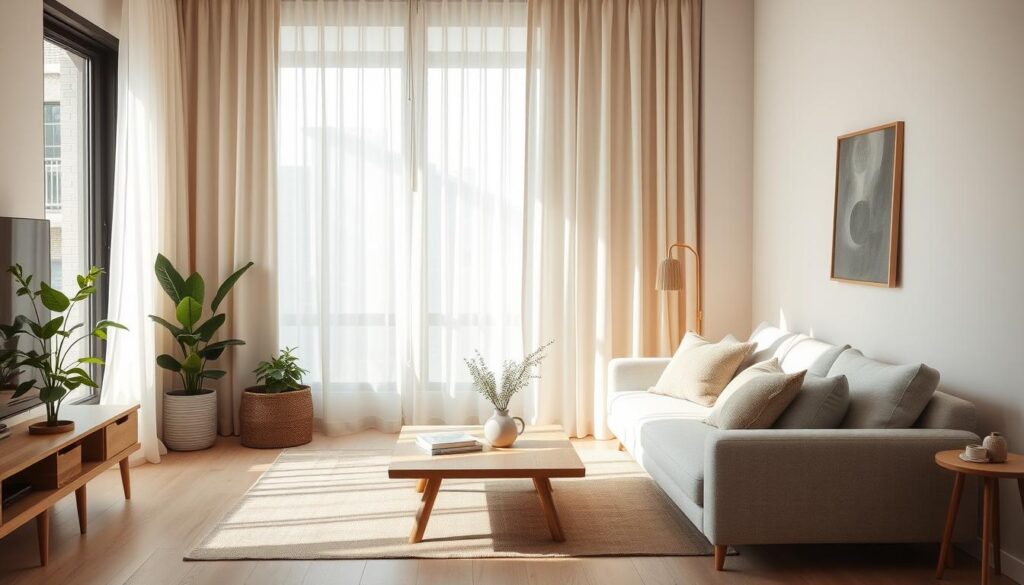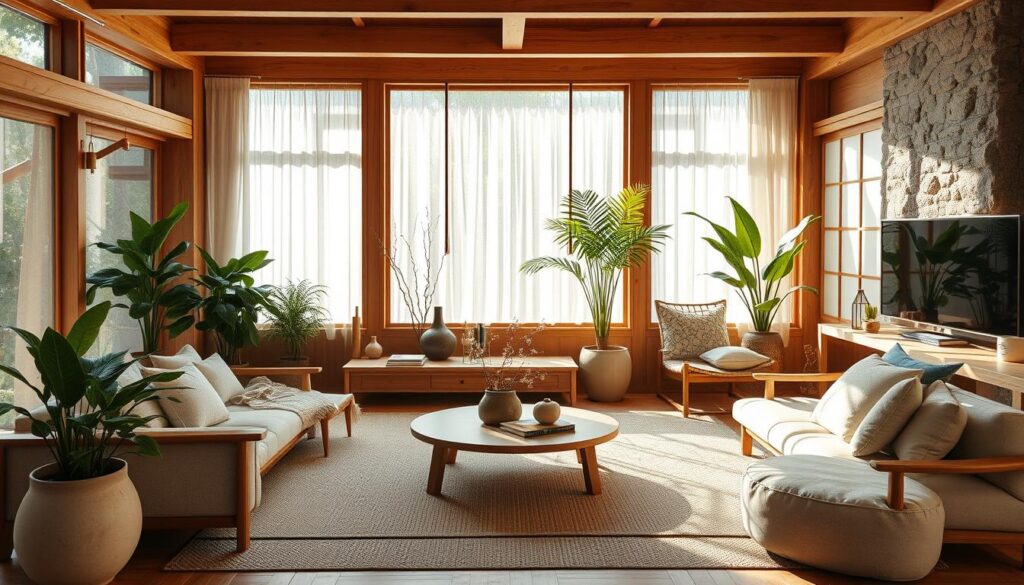Discover 10 stunning Japandi living room ideas that blend Japanese and Scandinavian design for a modern, minimalist aesthetic in your home. Get inspired now!
Japandi combines Japanese minimalism and Scandinavian functionality. It’s a design trend that makes living spaces calm and sophisticated. This mix of styles creates a peaceful and stylish home. It focuses on clean lines, natural materials, and quality over quantity.
Homeowners can make a Japandi living room that’s both beautiful and functional. It brings together the best of Japanese and Scandinavian design.
Key Takeaways
- Japandi interiors feature a neutral color palette of soft beiges, grays, and creams for a tranquil foundation.
- Natural materials, particularly wood, are a significant component of Japandi décor, contributing to warmth and authenticity.
- Minimalist furniture with clean lines, such as low-profile sofas and simple coffee tables, create an uncluttered aesthetic.
- Layered textures, including wool, linen, and patterned rugs, add coziness and softness to the minimalist design.
- Japanese-inspired details and Scandinavian design pieces seamlessly blend to achieve the Japandi aesthetic.
Embrace Neutral Tones for a Tranquil Foundation
The Japandi living room is all about calm and peace. Walls and big furniture pieces are painted in soft japandi beige, japandi gray, and japandi neutral colors. These colors make the room peaceful and welcoming.
Adding depth, japandi charcoal and stone-inspired tones are used. These darker colors add beauty without making the room feel crowded. They balance simplicity with interesting details.
The japandi color palette combines nature and clean lines for a calm feel. Using japandi neutral colors, people can make a peaceful space. It’s perfect for relaxing and enjoying the calm of Japandi living.
| Key Japandi Living Room Colors | Characteristics |
|---|---|
| Japandi beige | Soft, earthy tones that create a warm and inviting ambiance. |
| Japandi gray | Muted, cool-toned grays that add depth and sophistication. |
| Japandi charcoal | Deeper, richer shades that provide contrast and visual interest. |
| Japandi neutral colors | A harmonious blend of whites, creams, and natural tones that form the foundation of the Japandi color palette. |

“Neutral tones are essential in Japanese minimalism and contribute to an elegant and tranquil atmosphere.”
Incorporate Natural Materials for Warmth and Authenticity
Japandi design loves natural materials for their warmth and authenticity. These materials connect us to nature. Wooden furniture, stone, and concrete bring a minimalist yet inviting feel to spaces.
Wooden pieces like oak or walnut are key in Japandi design. They add depth and texture. Japandi wood furniture combines beauty with practicality, showing simplicity and usefulness.
Japandi bamboo and japandi rattan bring tranquility and nature into the room. They add visual interest and earthy elegance. This mix of textures and tones creates a peaceful atmosphere.

Japandi also uses modern materials like japandi stone and japandi concrete. These add an industrial look and contrast to the space. This mix of natural and industrial shows Japandi’s focus on minimalism and warmth.
“The fusion of Japanese and Scandinavian aesthetics in Japandi design results in a unique and harmonious style that celebrates natural materials and clean, uncluttered spaces.”
Japandi living rooms use many natural materials for authenticity and timelessness. They create a serene, inviting space that touches the senses and soul.
Opt for Minimalist Furniture with Clean Lines
In Japandi-inspired living rooms, focus on furniture with clean lines. Choose low-profile sofas, simple coffee tables, and streamlined media units. This creates a sense of space and harmony that matches the Japandi style.
Japandi style loves furniture with clean lines and simple shapes. It values functionality and practicality. Opt for low-profile sofas, sleek wooden coffee tables, and uncluttered shelving units to keep the room simple and not too full.
Use a neutral color scheme with whites, grays, beiges, and soft pastels. Add warmth with wool or cotton throws, plush rugs, and big floor cushions. This makes the space cozy and welcoming.
For decor, pick items that are useful and add beauty. Keep furniture and decor balanced and symmetrical for the japandi minimalist furniture look.
Embrace the Beauty of Clean Lines
- Select low-profile sofas with simple, streamlined silhouettes
- Opt for geometric, minimalist coffee tables in natural materials like wood or stone
- Choose uncluttered media units that seamlessly conceal electronic devices
- Incorporate functional storage solutions that maintain the room’s clean, organized appearance
| Japandi Furniture Piece | Key Characteristics |
|---|---|
| Japandi Sofa | Low-profile, clean lines, neutral upholstery |
| Japandi Coffee Table | Simple geometric shape, natural materials like wood or stone |
| Japandi Media Unit | Streamlined design, conceals electronic devices, minimalist appearance |
“The beauty of Japandi design lies in its minimalist approach to furniture, where every piece serves a purpose and contributes to the overall harmony of the space.”
Layer Textures to Add Coziness
The Japandi style loves minimalism but also values adding japandi textured decor for warmth. Soft materials like japandi wool and japandi linen are used for throws and blankets. These items make the furniture look softer and the space more inviting.
Patterned japandi rugs are key in the Japandi living room. They mark the seating area and add depth and interest. This layering of textures keeps the Japandi look simple yet cozy. It makes the space both beautiful and comfortable.
| Textural Element | Contribution to Japandi Style |
|---|---|
| Japandi Wool | Adds softness and warmth to the space |
| Japandi Linen | Introduces a natural, lightweight texture |
| Japandi Rugs | Defines the seating area and adds visual interest |
“The careful curation of textures is crucial in Japandi design, as it helps to create a harmonious and inviting living space that balances minimalism with comfort.”
Infuse Japanese-Inspired Details for Cultural Charm
To add a touch of Japanese charm to living rooms, designers use traditional elements. Japandi combines Japanese and Scandinavian styles. It creates a space that is both captivating and peaceful.
Shoji screens are a key Japanese detail. They have wooden frames and paper panels. These screens work as room dividers or decorations, filtering light softly and adding elegance.
Tatami mats are another important piece. They are made from straw and can make a cozy spot in the living room. Japandi tatami mats bring in natural textures and earthy tones, making the space calming and meditative.
A zen garden on the coffee table adds to the peaceful feel of the room. The japandi zen garden brings nature inside. It encourages quiet thought, fitting well with japandi japanese design.
These Japanese touches mix well with Scandinavian style, making a room that looks great and feels meaningful. Adding these elements brings depth and calm to the japandi look. It makes the living space welcoming and peaceful.
“The beauty of Japandi design lies in its ability to blend the simplicity and functionality of Scandinavian style with the cultural richness and natural harmony of Japanese aesthetics.”
Choose Scandinavian Design Pieces for Simplicity and Functionality
The Japandi design combines Japanese minimalism with Scandinavian functionality. This makes Scandinavian furniture and decor a great fit. Mid-century modern chairs with clean lines and ergonomic designs are perfect for Japandi style. They offer practical seating that looks timeless.
Japandi living rooms also feature functional storage like built-in shelves or coffee tables with hidden spots. These pieces help keep the space tidy and organized. Choosing Scandinavian-inspired furniture and storage supports the Japandi values of simplicity, practicality, and lasting design.
Japandi Functional Furniture and Storage Solutions
- Mid-century modern chairs with clean lines and ergonomic designs
- Built-in shelving units for organized storage
- Multifunctional coffee tables with hidden compartments
- Scandinavian-inspired media consoles and entertainment centers
- Modular or transformable furniture pieces for flexible living
| Japandi Design Element | Scandinavian Design Inspiration | Benefits |
|---|---|---|
| Minimalist Furniture | Mid-century modern chairs | Clean lines, ergonomic comfort, timeless appeal |
| Functional Storage | Built-in shelves, multifunctional tables | Organized, clutter-free living spaces |
| Flexible Living | Modular, transformable furniture | Adaptable to changing needs and layouts |
By mixing Scandinavian design with Japandi style, homeowners can make spaces that look great and work well. These spaces have a simple, comfy, and elegant look. It’s all about finding a balance that’s both beautiful and practical.
Play with Lighting for Ambiance and Depth
Lighting is key in creating a calm and deep look in a Japandi living room. Japandi lighting mixes Scandinavian minimalism with Japanese style’s natural beauty and elegance.
Pendant lamps add both light and style, hanging from the ceiling with a sleek look. Japandi pendant lights give off a warm, soft glow. Japandi floor lamps are sleek and provide focused light, also adding to the room’s style.
To make the space feel welcoming, Japandi interiors use japandi ambient lighting. This includes dimmable sconces or recessed lights that fill the room with a gentle light. This layered lighting approach not only lights up important areas but also adds depth and visual interest. It makes the room feel calm and sophisticated.
“Lighting is a crucial element in Japandi design, as it helps to create a harmonious and serene ambiance that reflects the principles of minimalism and natural harmony.”
By carefully choosing pendant, floor, and ambient lighting, you can make a Japandi living room that looks great and works well. This balance of style and function is perfect for any space.
Integrate Greenery for a Refreshing Touch of Nature
Embracing the Japandi design means bringing nature into your home. Adding japandi plants or a beautiful japandi hanging garden is key. This style loves greenery.
These plants make your space feel alive and clean the air. They also make the room peaceful and calm, just like the japandi nature look. By placing japandi indoor plants around, you connect the inside with the outside. This creates a strong bond with nature.
- Choose easy-care succulents or plants like the Snake Plant or Monstera Deliciosa to bring nature inside.
- Use hanging vines or baskets to add height and texture.
- Add big trees or large plants to make the space feel welcoming.
Adding plants to a Japandi living room makes it look better and feels good for you. It helps you feel close to nature. This way, you make a peaceful and refreshing space that shows the Japandi style.
Japandi Living Room: Create a Calm Color Palette
The japandi color palette is key to the calm and peaceful Japandi design. It uses soft japandi blue, japandi green, and japandi brown. These colors make the living room feel serene. They let the natural materials and simple decor shine, making the room peaceful and inviting.
Soft whites, creams, and grays are the main colors. They bring a clean and simple feel. Earthy browns add warmth and connect us to nature. Blues and greens bring in fresh and uplifting vibes.
Japandi living rooms focus on a simple color scheme. This lets the textures and simple furniture stand out. The colors reflect Japandi’s design and bring peace and calm, perfect for a modern, relaxing space.
| Color Group | Percentage of Occurrence | Description |
|---|---|---|
| Neutral Whites | 7.5% | Representing purity and simplicity, neutral whites create a clean backdrop for the space. |
| Soft Grays | 10% | Providing subtle depth and sophistication to the minimalist aesthetic. |
| Earthy Browns | 15% | Ranging from light sandy tones to deeper walnuts, earthy browns add warmth and a connection to nature. |
| Muted Greens | 17.5% | Reflecting an appreciation for plants and natural life, greens are often used in textiles and indoor plants. |
| Muted Blues | 25% | Introducing a soft, refreshing color to the serene palette. |
| Accent Colors | 20% | Adding visual interest and personality to the space, with the use of pastel pinks and black accents. |
“The Japandi color palette is a masterful blend of Scandinavian simplicity and Japanese serenity, creating a living space that is both visually captivating and emotionally calming.”
Incorporate Art and Accessories with Restraint
In the Japandi design, simplicity is key. Art and accessories are added with care and thought. Minimalist artworks, like abstract paintings or simple drawings, add beauty without taking over. Japandi pottery and vases in neutral tones are elegant touches that keep the room calm and balanced.
By choosing and placing these items wisely, Japandi living rooms stay peaceful and tidy. Every piece has a purpose, making the design better as a whole.
Minimalist Art and Handcrafted Accents
The Japandi style loves natural materials and simple design. This is true for the art and accessories in the room. Japandi art often shows simple, abstract scenes inspired by nature, like landscapes or organic shapes. These pieces add depth and interest without making the room feel busy.
Handcrafted pottery and vases are also key in Japandi living rooms. They add a real, natural feel and connect the room to nature. By picking and placing these items with care, the room stays elegant and harmonious. Every item has a role in making the design better.
| Design Element | Japandi Influence |
|---|---|
| Art | Minimalist, abstract, nature-inspired |
| Accessories | Handcrafted pottery, neutral-toned vases |
| Arrangement | Restrained, intentional, enhancing overall design |
“The beauty of Japandi design lies in its restraint and intentionality. Every piece in the living room, from the art to the accessories, is thoughtfully selected to create a serene and harmonious atmosphere.”
By adding japandi art and accessories carefully, Japandi living rooms become peaceful and balanced. This careful selection of minimalist art and handcrafted pieces is what makes Japandi design special. It creates a space that looks good and feels calming.
Incorporate Functional Decor for Practicality
In Japandi living room design, functionality is key. It combines Scandinavian minimalism with Japanese elegance. This means decor must look good and be useful. Japandi functional decor brings together beauty and practicality, making spaces both nice to look at and efficient.
The japandi storage ottoman is a great example of Japandi functional decor. It offers extra seating and hidden storage. This keeps the room tidy without losing its calm look. Japandi built-in shelving and japandi multifunctional tables also help keep things organized, making the space both beautiful and useful.
Using these pieces, homeowners can keep their living room calm and minimal. Yet, it stays practical and looks good. This creates a space that is both beautiful and functional, offering a peaceful, zen-like feel.
“In Japandi design, there is a strong emphasis on creating spaces that are not only aesthetically pleasing but also highly practical and functional.”
Japandi decor values simplicity, natural materials, and smart design. By choosing pieces that do more than one thing, you can make a living room that looks great and is easy to live in. This approach to design makes Japandi unique, creating spaces that support your well-being.
Conclusion: Embrace the Zen of Japandi Living
The Japandi living room design combines Japanese minimalism and Scandinavian functionality. It creates spaces that look great and are easy to live in. Using neutral colors, natural materials, and clean lines makes a room look simple yet elegant.
This design helps create a calm and balanced atmosphere. It uses minimalist furniture, practical lighting, and natural accents. This way, living rooms become peaceful places that show the beauty of simplicity and mindful living.
Living with Japandi means making a space that feeds the soul. It’s a place where the busy world outside disappears. By adding Japandi design elements, homeowners can make their living rooms into peaceful retreats. These spaces blend Japanese and Scandinavian design ideas beautifully.













